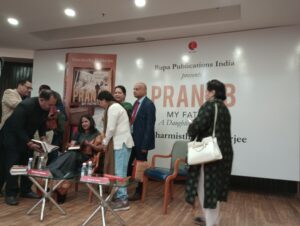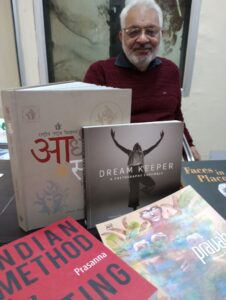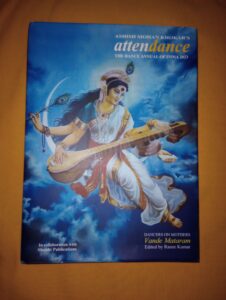Pranab and Pohoja

Pranab Mukherjee – the giant of Indian politics – was the subject of the book his daughter Sharmistha penned, based on his diaries. A daughter remembers . The book is taut but for some fraught with trepidation as to what has been stated. It is as Sharmistha is: no nonsense, straight forward, honest and clear.
Having known her for some 35 years, and worked together in dance documentation field (our TV dance serial made for DD One the highest TRPs those days in 1996 then our performance tour twice to Sweden for the Queen no less), this is one politicians’ progeny that has not benefitted from her father’s office, which otherwise is mostly the norm in India. No one even questions if the child of a neta is qualified, has aptitude and can perform or deliver. The Pranab Mukherjee family have been an epitome of propriety , professional behaviour and probity in public life.
The title is pithy, almost odd to Indian traditional sensibilities to be call a senior statesman – your own father- just by first name. Maybe it is very modern and American style but Pranab da was, at home, a traditional family man. His photos in public domain going to his village in Bengal for Durga Puja every year and seeing the non frill family even in Delhi is a lesson for all. Imagine a minister for long, almost 40 years, and his wife used an old green fiat for personal work. He didn’t spoil his children or indulge them. One even lives in a DDA flat in Munirka while ordinary MLAs of Delhi have got farmhouses with pools.
Sharmistha herself never availed any visible undue favour (Padma award for dance) or foreign trip through any official agency and if ever she was treated on par with others, even when abroad. Once an Ambassador of India was shocked and shared “is this really a politician’s child? That too our Foreign Minister’s daughter? She has been here a few days, and made no demands for shopping, cars or anything extra. Most unusual and cultured”.
This is true culture, hence in this column. What others see is everything; don’t think no one is watching or knows. There are eyes everywhere and now your cell itself can tell you that your flight to catch is in three hours please reach airport and when your do, buy this from this shop!

The book launch was Delhi mayanagari in essence, even at a hallowed multi purpose hall of IIC. All wanted to be seen and photographed, some just for publicity on face book even if their faces said they could hardly read or write. Others were old hanger-ons and courtiers of typical Delhi Darbar culture. Only a few genuine (read, old , cultured lot) sat quietly and watched it all. One rookie reporter sat net to me and took copious notes. Another old gentleman tried hard to write on a paper without a hard base , so I loaned him my copy of the book I had bought at the outset to support the cause.
Books they say , are our best friends. But who makes them come to life? Who births them? An author writes. Who gives it shape, who packs pages between two covers to make it reach and be readable? A printer. While the content is by the writer, the printer makes it visible and reach audiences. How often we take printers for granted?
PPP: Printer Pohoja of Patparganj ! Sounds like a poem. Anil Pohoja ( not Punjabi Ahuja but from Multan, Pohoja) is his name and printing his passion. A child of Partition of India, he is all of 68 with best set up and supply systems in printing to such cultural bodies , VIP foundations and ministry of culture institutions and many art galleries. He has other business interests too over the hills and in subways but printing remains his first love. He supervises each book, each poster, each brochure and certificate. He takes pride in his work that’s what the Punjabi spirit is all about. Hailing from Multan ,his whole family came to Delhi and it is hard working honest people like him who have made Delhi prosper. They have big hearts and help others by the time they achieve success. It’s nice to see such professionals because where I live – high tech city called Bangalore – there are just a handful of printers to be found. For 25 years I’ve looked and not even 3, who can deliver, want to work or are even interested! The climate is good, roads are very bad so no one wants to move.

And the mover and shakers of Delhi were in attendance to Sharmistha’s book launch. For a first book it is very well written. The subject is so layered and such a complex one that no matter how circumspect is the writer, the slip can show somewhere. And it is political . Anything written can be and will be inspected, introspected and quoted or mis quoted. Sharmistha herself is clear:” It is my understanding of those nottings in the diaries of my father left with me.” It is as Pranab da would have wanted it to be. Fair and square. Read it to know more. Published by Rupa & co. It is only Rs 700 .
Books are on way out? But how many lit fests have sprung up everywhere! Gawd… Every city has one. So, who is attending? Bangalore last fortnight over 15,000 attended. Bangalore has maximum of bookshops in the country, after the captial city Delhi. Over 50. As a self publisher, I had to learn distribution 25 years ago. So long big publishers like Rupa, Roli, Rutledge published our books I didn’t have to worry about outreach. One rarely earned monies but earned name as the companies had pan- Indian distribution network. Small town to big. It was a maze. How physically a book travelled to Jalandhar or Japan! Those days it was a delight to see ones books in airport bookshops in cities like Ahmedabad where no one read much! It has the distinction of having only one – read – my – lips, again- one bookshop! Crossword those days, right opposite Mrinalini Sarabhai’s institution Darpana. Baroda had two! University town so one more than Ahmedabad. Bombay 10. Kolkata a whole street selling books called the College Street! Madras 20, mostly in old hotels like Connemara and Taj and by-lanes of Mylapore and Mandaveli , till Anna Nagar and Kilpauk came up. Bhubaneswar one. Chandigarh three. All in sector 17 or 22. Kerala, airports and tourists hotels. That was the broad canvass then. Today? Internet has changed and many bookshelf have closed. Besides any book can be had on Amazon. Amazing. But then why do many lit fests? Drama or marketing tool?

And yet young ones are reading more face book than real books. Where’s the gap? Digital. Has technology made the transition easier? The book culture stands changed forever which is why reading a book is important; possessing one, a matter of joy. It is one friend that stays with you for ever. I’m grateful Saraswati was extra kind to some of us; Laxmi comes and goes!
Gold standard of art writing, documentation and dance history comes from sustained work in the field for almost 50 years; 47 books, 5000 articles, 3 monthly columns for decades and one yearbook -attenDance. Add cultural administration from 1980s onwards; teaching at universities dance modules, 85 such for UGC E-PATHSHALA and advisor to NEEMRANA group and IGNCA. On board of several institutions, organisations and NGOs make him a truly cultural icon of young India that bridges tradition with old Bharat. Ashish Khokar truly loves and serves Indian arts and culture selflessly.


